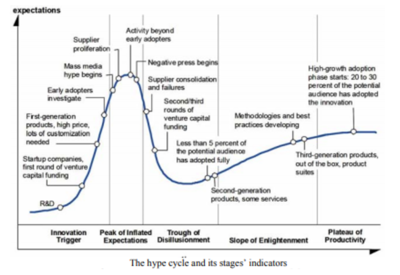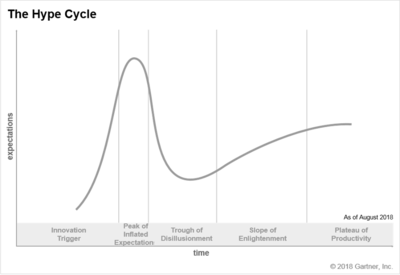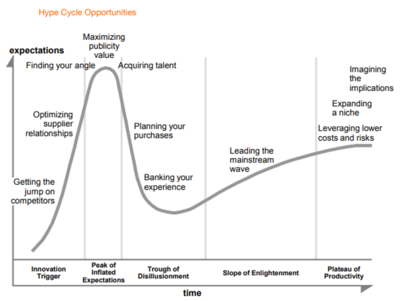Gartner's Hype Cycle Methodology
What is Gartner's Hype Cycle Methodology
Gartner Hype Cycles provide a graphic representation of the maturity and adoption of technologies and applications, and how they are potentially relevant to solving real business problems and exploiting new opportunities. Gartner Hype Cycle methodology gives you a view of how a technology or application will evolve over time, providing a sound source of insight to manage its deployment within the context of your specific business goals.
Each year, Gartner creates more than 100 Hype Cycles in various domains to enable clients to track innovation maturity and future potential. Hype Cycles characterize the typical progression of innovation, from overenthusiasm through a period of disillusionment to an eventual understanding of the innovation’s relevance and role in a market or domain.[1]
History of Hype Cycle[2]
The concept of Hype Cycle was introduced by an analyst called Jackie Fenn in the year 1995. For several years of trying to bring this technology into the industry view, the organization began to use Hype Cycle charts of new and budding technologies. If we now go back and see the growth of old technologies, we will be able to observe and validate the curves and arches in the graphical representation. As an effective example, in the year 2005, a technology called Business Process Management or BPM suites was at the top of the Hype Cycle which means that its hype at that time was at the highest. Now a decade later, BPM has most certainly lived up to the Hype. But it is also interesting to note that the technology of Tablets was at the bottom at that time, but it has now emerged to be very useful all over the world.
If you consider the year 2014, the technology that was at the peak of Hype Cycles was ‘Internet of Things’ and the technology at the bottom is ‘White Cloud Computing’. We know where they both are today.
Hyple Cycle Phases[3]
The s-curve shape of the technology maturity is based on the notion hat the performance or in this case particular maturity of a technology develops only slowly in the beginning. Its fundamentals are poorly understood and investments into pilots and early adoptions may result only into little performance gains. Depending on the technology, at some turning point the technology performance is supposed to take off until a plateau, defined by the technology’s specific limits, is reached. The resulting hype cycle shape is depicted in the figure below. Its path can be divided into five distinct phases: innovation trigger, peak of inflated expectations, through of disillusionment, slope of enlightenment, and plateau of productivity. For each phase some indictors are defined (see figure below) They allow judging the current stage for any given technology.

source: Martin Steinert et al.
- Innovation Trigger: A public announcement or demonstration triggers the cycle. Awareness about the technology starts to spread and attracts first media coverage. Venture capitalists and adopting companies are aiming to capitalize on possible first mover advantages.
- Peak of Inflated Expectations: This phase is characterized by high expectations boosted or hyped further by media coverage. Following a bandwagon effect, companies invest without having a clear strategy or sound business case.
- Trough of Disillusionment: The over-enthusiasm and hyped investments result in commercial adoptions that fail to meet performance and/or revenue expectations. Public disappointments spreads and are again hyped by media, this time negatively.
- Slope of Enlightenment: Some early adopters who continued working with the technology begin to experience net benefits and regain motivation. With more investments, the contextual understanding of the technology grows, resulting in increasing performance. The technology begins to be socialized.
- Plateau of Productivity: The technology is realistically valued. Following successful market place demonstrations, the adoption accelerates.
The horizontal axis of the Hype Cycle is labeled “time.” This is because a single innovation will progress through each stage as time passes. In practice, most Gartner Hype Cycles are a snapshot showing the relative positions of a set of innovation profiles at a single point in time. However, single-topic Hype Cycles can be useful for predicting the future path of an innovation. One notable example was the e-business Hype Cycle published in 1999, which accurately predicted the dot-com bust of 2001 and the eventual emergence of e-business as “business as usual.”
The vertical axis is labeled “expectations.” The distinctive vertical shape of the Hype Cycle curve shows how expectations surge and contract over time as an innovation progresses, based on the marketplace’s assessment of its future expected value. Originally, the vertical axis was labeled “visibility,” but we changed this in 2009. The original label focused on the level of buzz and market discourse that drives the peak. The current label more accurately reflects the deeper root cause and nature of the buzz as the innovation progresses. For example, an innovation may be in the trough yet still visible in the form of negative press. In particular, the current label highlights the changing views of potential and actual adopters of the innovation, and the shifting pressures surrounding investment decisions. The Hype Cycle shows two stages of upward direction (that is, increasing expectations):
- The rise up to the Peak of Inflated Expectations
- The rise up to the Slope of Enlightenment
The first rise is due to the excitement about the new opportunities the innovation will bring, driven mostly by market hype. The second rise of increasing expectations is driven by the increase in maturity of the innovation, which leads to real value and fulfilled expectations. The vertical scale of each innovation’s hype curve typically varies, based on the innovation’s overall perceived importance to business and society. The Hype Cycle ends at the start of the Plateau of Productivity, where mainstream adoption of the innovation surges. As with the height of the Peak of Inflated Expectations, the final height of the Plateau of Productivity varies. Its height reflects whether the innovation is broadly applicable and highly visible, or benefits only a niche market.
The time between the peak of inflated expectations and the plateau of productivity has been termed as time-to-value gap. Depending on each technologies performance constraints, integration complexity and penetration potential, this gap may differ. As a consequence, the hype cycle is supposed to vary between two years and two decades. Whereas normal technologies take five to eight years, fast track technologies need only two to four years to maturity (indicators: technology high value, simplicity of use, several powerful vendors, existing infrastructure, rapid transition from B2C to B2B, benefits easily quantifiable). To the contrary, long fuse technologies may go through several troughs and hypes (indicators: science fiction style fascination, complexity and need for basic sciences, skills in short supply, need new infrastructure, regulatory issues, depends on new business models).
Based on the annual monitoring and hype cycle analysis of around 1,500 commercially viable technologies, trends and application in eighty IT, business and consumer markets, Gartner elaborates numerous hype cycle reports for industries, and derives consulting advices for specific client companies.
Different Technology, Different Expectations Change[4]
In the Gartner Hype Cycle, each phase represents a specific magnitude of expectations. These maturity phases progress differently for every technology innovation:
- Some technologies stay at one phase longer than others, which contributes to their expected value in the industry accordingly.
- Some technology innovations follow through the maturity lifecycle faster than others, eventually reaching the final state of Plateau of Productivity. This is where the industry has adopted the said technology at scale and the perceived value translates into its real value.
- Not all technology trends follow the entire maturity lifecycle. Some fail to live up to their hype, disappearing from the hype cycle altogether. This behavior suggests that the real value was evaluated early during their maturity lifecycle and the promised rewards were deemed unrealistic or unfeasible.
- Certain innovations tend to transition back and forth between the maturity phases. Reasons include the evolution of the technology itself, where it presents new value promises as it evolves.
- The scope of evaluation changes over time. As the technology industry evolves, its appetite for risk and circumstances change. The values are perceived accordingly, and technology innovations don’t maintain a consistent magnitude of expected value over prolonged time periods.
Why the Hype Cycle Matters: Traps and Opportunities[5]
The constant barrage of positive and negative hype often leads organizations to behave in ways that may not represent the best use of their resources. The peaks and troughs of the Hype Cycle exert pressure to adopt risky technologies without knowing the potential value, and also mask opportunities to embrace less-visible technologies that may be highly relevant. This leads to the four traps of the Hype Cycle — adopting too early, giving up too soon, adopting too late or hanging on too long. (see figure below)
- Adopting Too Early and Giving Up Too Soon: Technologies should not be adopted just because they are at the Peak of Inflated Expectations, nor should they necessarily be abandoned at the Trough of Disillusionment. Rather, enterprises should identify which technologies are potentially beneficial to their business and evaluate those items earlier in the Hype Cycle. The additional risk of adopting early is justified only for potentially high-benefit technologies. Although this sounds like common sense, the intense market pressure to "keep up" with other organizations drives a bandwagon effect of trend-driven innovation adoption (e.g., social media from 2007 to 2009 and cloud computing from 2008 to 2010). A major role of those who understand and work with the Hype Cycle is to "flatten" the peak and trough within their organizations to drive more realistic expectations. The Hype Cycle is most useful in explaining why the recommendations of technology planning groups may be different from what enterprises are hearing or reading in the media. At the Peak of Inflated Expectations, technology planners will caution, "Don't get caught up in the hype. Let's adopt it only if it is strategically important to us. Otherwise, let's wait for others to learn the hard lessons." In the Trough of Disillusionment, technology planners will recommend, "Let's start looking at the technology now because there are some solid products emerging, as well as real-world experience about how to use the technology."
- Adopting Too Late: Beware of the "noise filter" that most business and IT strategists apply as an essential coping strategy in a world of information overload. By blocking out all but the most visible trends, planners find their attention limited to two points on the Hype Cycle: the Peak of Inflated Expectations (when the noise overwhelms the lter) and the Plateau of Productivity (when the actions of successful competitors become a problem). During the Trough of Disillusionment and early Slope of Enlightenment phases, the filter can create a blind spot that may cause an enterprise to miss some urgent and important opportunities. This is compounded by the fact that the peak and trough are very visible shifts, but the beginning of the slope can be a much more subtle change, and thus easier to miss. If an organization finds a potentially interesting technology early in the Hype Cycle but planners feel that the technology is not yet ready, a good strategy is to identify target performance levels or price points and track progress through the "quiet phase" to identify when the technology is finally ready to drive value.
- Hanging On Too Long: Although Gartner only plots technologies on the Hype Cycle up to the beginning of the Plateau of Productivity, a full Hype Cycle could be viewed as extending to a "Swamp of Diminishing Returns" when legacy systems start to bog down new initiatives, and a "Cliff of Obsolescence" where maintaining the system becomes a significant pain point. Like the beginning of the slope, the decline into these end-of-life issues can be slow and easily missed until they start to cause problems. Gartner's IT Market Clocks address these phases of the life cycle in more detail.
While it's important to understand the traps that can snare unwary adopters, it's equally important to examine the opportunities that arise from the inevitability of the Hype Cycle. Anytime you can predict major shifts in behavior — such as the major turning points on the Hype Cycle — you can take advantage by being ahead of the crowd. Two types of opportunity arise from the Hype Cycle. The first set of opportunities comes from timing your adoption of each innovation with precision to optimize the amount of value you can derive. If you're going to invest your organization's time and money (and also some of its limited capacity for change) in an innovation, you want to make sure not only that it's the right one, but that you jump in at a time when you'll receive the longest lifetime value at an acceptable level of risk. The second type of opportunity lies in harnessing the energy of the Hype Cycle in the broader marketplace by taking advantage of the needs and actions of other players. Avoiding the traps that others fall into is one element of this. If you can be smarter than the crowd even some of the time in avoiding the money pits of adopting too early or giving up too soon, and the lost opportunity costs of adopting too late or hanging on too long, you'll come out ahead. But if, on top of that, you can anticipate the tendencies of suppliers, investors, competitors, and skilled individuals at each stage of the Hype Cycle, you'll be able to find the best deals, the best talent, the best publicity, and many other opportunities to advance your innovation adoption efforts (see Figure below).
Hype Cycles help you:
- Separate hype from the real drivers of a technology’s commercial promise
- Reduce the risk of your technology investment decisions
- Compare your understanding of a technology’s business value with the objectivity of experienced IT analysts
Criticisms of Gartner's Hype Cycle[6]
There have been numerous criticisms of the hype cycle, prominent among which are that it is not a cycle, that the outcome does not depend on the nature of the technology itself, that it is not scientific in nature, and that it does not reflect changes over time in the speed at which technology develops. Another is that it is limited in its application, as it prioritizes economic considerations in decision-making processes. It seems to assume that a business' performance is tied to the hype cycle, whereas this may actually have more to do with the way a company devises its branding strategy. A related criticism is that the "cycle" has no real benefits to the development ormarketing of new technologies and merely comments on pre-existing trends. Specific disadvantages when compared to, for example, technology readiness level are:
- The cycle is not scientific in nature, and there is no data or analysis that would justify the cycle.
- With the (subjective) terms disillusionment, enlightenment and expectations it can not be described objectively or clearly where technology now really is.
- The terms are misleading in the sense that one gets the wrong idea what they can use a technology for. The user does not want to be disappointed, so should they stay away from technology in the Trough of Disillusionment?
- No action perspective is offered to move technology to a next phase.
- This appears to be a very simplified impulse response of an elastic system representable by a differential equation. Perhaps more telling would be to formulate a system model with solutions conforming to observable behavior.
An analysis of Gartner Hype Cycles since 2000 shows that few technologies actually travel through an identifiable hype cycle, and that in practice most of the important technologies adopted since 2000 were not identified early in their adoption cycles.
References
- ↑ Definition - What is Gartner's Hype Cycle Methodology? Gartner
- ↑ History of Hype Cycle Cleverism
- ↑ What are the 5 Stages of Gartner's Hype Cycle? Martin Steinert, Larry John Leifer
- ↑ What do the different phases of Gartner's Hype Cycle represent? BMC
- ↑ Why the Hype Cycle Matters: Traps and Opportunities Jackie Fenn, Mark Raskino, Betsy Burton
- ↑ Criticisms of Gartner's Hype Cycle Wikipedia
Further Reading
- Gartner 2019 Hype Cycle for Emerging Technologies. What’s in it for AI leaders? Towards Data Science
- What’s New In Gartner’s Hype Cycle For AI, 2020 Forbes
- One thing everybody forgets about Gartner’s hype cycle Scott Brinker



